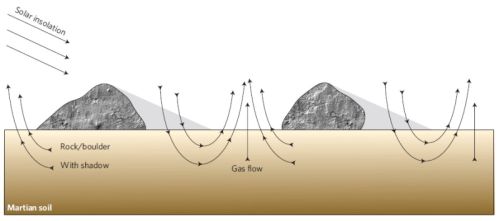Recent research claims that planet Mars might act as an enormous gas pump with its low atmospheric pressure and porous soil making the assertion strong enough to prove the hypothesis. Space scientists have already advocated the constant activity that is going on the surface like dust storms and drifting dunes. And now, the new study holds the certainty of having a similar kind of motion underneath the surface as well.
With this assertion, the planet becomes the solar system’s first such body in which continuous pumping on a massive scale is occurring naturally. Unlike on Earth, this phenomenon might also lead to transportation of water vapor across Mar’s surface.
While the scientists were doing research on Martian soil, they observed that eroded particles were being descended towards the surface without the presence of any thermal convection. Hence, they hypothesized the presence of gas flow might be responsible for the effect. Researchers further added that their conjecture added the phenomena of gas flow along with diffusion, which was considered as the only transport mechanism on the planet so far.
The low atmospheric pressure that is around 6 mbar – 1% less than planet Earth- has been responsible for the newly discovered mechanism. Since the Martian atmosphere is saturated with co2, the low pressure will give the molecules a free path, on an average, it’ll be 10 μm, where low path means, the distance between consecutive collisions with each other.
Notably, the sizes of dust particles and the paths or the pores on the surface happen to fall on the same order of 10 μm. This gives rise to an effect named ‘thermal creep’. By definition, it means, pores take the role of a pump and transfer gas from the colder side to the warmer side.
Researchers hold the view that this thermal creep might play a vital role in transporting molecules of gas and dust on the surface of the planet. Where the pores might act as an efficient pump transporting the gas molecules from the colder regions under soil or shadowy area where the sun couldn’t reach and transfer them to the warmer regions. Thus, the entities are absorbed by the colder part of the soil but turning the opposite as erupting out from a heated region of the surface.
This new findings pertaining to the cycle of water vapor could give rise to the possibilities of environments that might have existed on the planet Mars so far. Along with this scientists are also expecting a similar behavior of the flow of gas through porous material in protoplanetary disks as they assume that the bodies too have a low-pressure environment.




